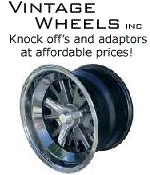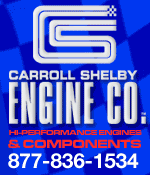 
 Main Menu
Main Menu
|
 Nevada Classics
Nevada Classics
|
 Advertise at CC
Advertise at CC
|
 January 2025
January 2025
|
| S |
M |
T |
W |
T |
F |
S |
| |
|
|
1 |
2 |
3 |
4 |
| 5 |
6 |
7 |
8 |
9 |
10 |
11 |
| 12 |
13 |
14 |
15 |
16 |
17 |
18 |
| 19 |
20 |
21 |
22 |
23 |
24 |
25 |
| 26 |
27 |
28 |
29 |
30 |
31 |
|
|
 CC Advertisers
CC Advertisers
|
|

01-17-2005, 06:06 AM
|
 |
Senior Club Cobra Member

|
|
|
Join Date: Dec 2001
Location: Shasta Lake,
CA
Cobra Make, Engine:
Posts: 26,597
|
|

 Not Ranked
Not Ranked
 Question abour 19,000 RPM
Question abour 19,000 RPM
For all of you guy's, or gals, out there that are familiar with or race the Indy type engines that will turn in the 13,000 - 19,000 RPM range, could you give me a basic explanation of just how they achieve that? I am sure it isn't with a conventionl push rod setup as I can't see that handling those RPMs very long. Also could you give me some idea of the horsepower and torque and the ranges it comes in? I have looked around at books here and still can't find what I really want to know. This is just a for my information question as I have no intentions of building one, but have long been interested in just how they accomplish what they do. Also I think I saw or heard on one of the broadcasts that they use very small clutches and the cars weigh around 1500 pounds. Is this correct, and if so how that compare with a Forumla type car?
Thanks,
Ron  |
-
Advertising


01-17-2005, 06:35 AM
|
 |
CC Member

|
|
|
Join Date: Oct 2004
Location: Massapequa,
NY
Cobra Make, Engine: ERA 427SC #621 silver/black stripes /427 center oiler
Posts: 163
|
|

 Not Ranked
Not Ranked
http://www.abc.net.au/science/k2/moments/s282081.htm
Ron, try this link. It should explain how they achieve 18,000 RPM's.
Pat
__________________
Pat
Last edited by P Martin; 01-17-2005 at 08:32 AM..
|

01-17-2005, 06:36 AM
|
|
CC Member

|
|
|
Join Date: Dec 2001
Location: Louisville,
KY
Cobra Make, Engine: I'm Cobra-less!
Posts: 9,417
|
|

 Not Ranked
Not Ranked
I think you're right on most cases Ron.....very small clutches....and I'm pretty sure they are 1500 or less.
Most of the V8's they use are overhead cam I believe. No pushrods....All valvetrain components are as light as they can get without compromising strenght.....titanium valves, spring retainers, valve locks, etc....
I was looking around on the internet and even did some research on this while in engineering school....there are a couple of race teams experimenting with computer controlled valve actuators....no cam. The computer tells the valve when to open.
If I remember correctly, the torque and horsepower ranges are extremely high.....I think way up in the rpm range....Kinda like a crotch rocket street bike....
Also pretty sure they idle at around 5-8k rpm.....
|

01-17-2005, 06:43 AM
|
 |
Senior Club Cobra Member

|
|
|
Join Date: Dec 2001
Location: Shasta Lake,
CA
Cobra Make, Engine:
Posts: 26,597
|
|

 Not Ranked
Not Ranked
Thanks guys,
That will give me some reading to do now and maybe I will understand a little more about those high revving engines.
Ron  |

01-17-2005, 08:05 AM
|
|
Senior Club Cobra Member

|
|
|
Join Date: Jul 2002
Cobra Make, Engine:
Posts: 15,712
|
|

 Not Ranked
Not Ranked

Some engines, like BMW, are turning 22,000 rpm, but with a shift point closer to 20,500 for more reliability. They still use a classic camshaft, but have NO VALVE SPRINGS! Somehow they use pneumatic pressure in place of a valve spring, or electro mechanical (magnetic?) of some nature. I've never seen a picture and would sure LIKE to see how this "pressure" is applied to the valve in lieu of a spring.
At this rpm (20K plus) the limiting factor is the fuel BURN RATE! The flame travel is to slow. Another limiting factor is friction and mass. Diminishing returns as the rpm goes up because it takes more horse power to overcome the friction, so you get a catch 22.
Fuel additives are being experimented with to speed up the burn but more importantly to reduce friction on the top piston ring.
I've heard of idle speeds in the 4000-5000 rpm range. One of the issues with these engines is the "explosion" of power at a certain rpm range making the vehicle difficult to control. An engine with less power but a flatter torque/horse power curve allows for more drive control. Some teams are taking this approach and it seems the F1 engine "wars" are less about ultimate horse power and more about controlling the output.
This IS a fascinating subject and difficult to get specific information on. I'm not sure WHY that is, perhaps the engine guys are hiding it?
There are some "camless" engines that use electro\mechanical valve actuators. That may be banned in the future. Camless engines, the next generation piston engine?
Last edited by Excaliber; 01-17-2005 at 08:17 AM..
|

01-17-2005, 08:17 AM
|
|
CC Member

|
|
|
Join Date: Oct 2003
Posts: 4,078
|
|

 Not Ranked
Not Ranked
P Martin,
Would you mind checking that link? It comes up "cannot be found.."
Thank you for help on this interesting subject.
__________________
Chas.
|

01-17-2005, 08:34 AM
|
 |
CC Member

|
|
|
Join Date: Oct 2004
Location: Massapequa,
NY
Cobra Make, Engine: ERA 427SC #621 silver/black stripes /427 center oiler
Posts: 163
|
|

 Not Ranked
Not Ranked
oops! Try it now, I edited my post. I had a mis-placed comma.
Pat
__________________
Pat
|

01-17-2005, 08:34 AM
|
 |
CC Member

|
|
|
Join Date: Jan 2003
Location: Atlanta,
GA
Cobra Make, Engine: CAV GT40 with 331 KC
Posts: 2,187
|
|

 Not Ranked
Not Ranked
Ron,
They use air to close the valves, they are made out of materials that we only read about that are super light and strong, the highest I have ever seen one rev to (watching the data read out on screen) is about 19,500 rpm, the engine are 3.0 liters (183 cubes) right now but they are reducing engine size to 2.4 liters in the near future to limit horsepower - current horsepower is about 850 and I have never seen a torque figure published.... they also use 7 speed transmissions with tiny little clutches. Shifting is electro-pnuematic with pressures in the 3500 psi range! I heard one engineer say that when the shift button is pushed, the transmission WILL shift NOW.
Total car weight empty is about 1100 pounds -
Most "open wheel" cars are formula cars - (sprinters and midgets are not usually referred to as formula cars - too french I assume- ) as they are built to race to a racing formula....
|

01-17-2005, 11:50 AM
|
 |
CC Member

|
|
|
Join Date: Mar 2001
Location: Westminster CA USA,
CA
Cobra Make, Engine: SPF812; 427 Windsor
Posts: 14
|
|

 Not Ranked
Not Ranked

Hey now here is a subject I really know about!!!
As a member of Cosworth Racing for almost 13 year now, I can tell you a few things about what it takes to rev an engine to the moon and still see the checkered flag on the last lap....
I've spent all my time at Cosworth working with Champ Car (formerly CART). I do have some insight to F-1 and the IRL or IndyCar series as well.
First and formost, the Champ Car engines make anywhere from 750 to 925 hp and about 400 ftlbs of torque.
Power depends on boost setting which has changed many times over the years.
At 925 hp, the boost was approximately 40 inhg.
We have revved ours to as high as 17,000 rpm!
This is a turbo-charged V-8 Engine (2.65 ltr).
The valve train is conventional steel wire spring with titanium valves and retainers.
To make them live at those speeds, cam profile and spring wire material are crucial!
If I told you more, I'd have to kill ya!
The clutches are multi-plate sintered steel units that are about 5 inches in diameter.
The cars weigh in at 1550 lbs (no fuel or driver).
All the engine related controls are handled through Cosworth software and elctronics.
Shifting on a Champ Car is manual however, all the driver has to do is pull or puch the shifter, the elctronics do the rest.
A good shift on a Champ Car takes about 40 ms, an F-1 car is about a 3rd of that!
An F-1 engine is indeed very similar to a Champ Cars however, they do currently use V-10's at 3 ltrs.
Our F-1 engine can race all day at close to 20K rpm!
We use pnuematic valve springs with conventional over head cams (both series run 4 valve per cyl).
And as you can imagine, the materials in an F-1 car can only be described as "Un-obtanium". More carbon fiber than you could ever imagine!
Their clutches are controled by the electronics package.
They are multi disc carbon fiber units that can cost as much as my SPF-Cobra!
All driver controled functions are done through the steering wheel (about 20 seperate switches and knobs).
I could go on and on (it's my passion)........
The most exciting part of my 13 years at Cosworth came in late 2003 when I was invited to drive one of the million dollar Players Cigarette cars!
I did 6 laps at Las Vegas Speedways road course!
800 Hp in a 1550 pound car is almost indescribable!
I'm still smiling!
Hope this helps.
Ken

|

01-17-2005, 12:04 PM
|
 |
Senior Club Cobra Member

|
|
|
Join Date: Dec 2001
Location: Shasta Lake,
CA
Cobra Make, Engine:
Posts: 26,597
|
|

 Not Ranked
Not Ranked
Thanks to all of you for the answers. That 18,000 to 20,000 RPM range was just mind boggling to me. I knew they had to have some kind of trick stuff for valves and such. I also heard them mention what one of the gear boxes cost and it was out of sight.
Ken,
Thanks for taking the time to tell me what you did. I watched them interview one of the older drivers back from before all the turbo charging and everything, and he had taken a test drive in one of the cars that ran in the class he used to. I believe his statement was, Thank God I didn't have to drive that much power and so fast. He said that when the power kicked in he almost lost control of the car. All interesting to me as I have never even sit in one of those type cars, let alone driven one. Now if I could just get one to make one run through Redding. 
Ron  |

01-17-2005, 12:07 PM
|
|
Senior Club Cobra Member

|
|
|
Join Date: Jul 2002
Cobra Make, Engine:
Posts: 15,712
|
|

 Not Ranked
Not Ranked
I've heard about some TWO CYCLE small engines also running 22,000 rpm. Coincidence or fuel burn rate limitation?
What is the max rpm anyone else has heard of with two cycle?
Rotary engine?
Sure would like a picture of how those pneumatic valves actuate. What type of "air" do they use? How is the "air charge" for the valves maintained/recharged during a race? PSI?
...and Ken, it's OK to tell US what the "unobtainium" is, our lips are sealed.  |

01-17-2005, 12:12 PM
|
 |
Senior Club Cobra Member

|
|
|
Join Date: Mar 2001
Location: Southern Connecticut,
CT
Cobra Make, Engine: SPF - 351W, 944 non-turbo
Posts: 2,105
|
|

 Not Ranked
Not Ranked
Ron:
I don't know how they do it but I know why they do it.
HP = (torque X rpm) / 5252. This means that an engine that produces 300 HP at 6,000 rpm will have 900 HP at 18,000 rpm if it can maintain the same torque. Unlike the street, in racing it's all about Horse Power.
Keep in mind that at 18,000 rpm the pistons are going up and down 300 times per second. Makes you wonder if the fuel burn can keep up.
Bob
|

01-17-2005, 01:00 PM
|
 |
Senior Club Cobra Member

|
|
|
Join Date: Dec 2001
Location: Shasta Lake,
CA
Cobra Make, Engine:
Posts: 26,597
|
|

 Not Ranked
Not Ranked
Bob,
I knew the higher RPM gave more horsepower, but I was more curious as to haw they madea valvetrain and such that would function at that range for a long period of time. 
Ernie,
I have heard of those pneumatic valve set ups before and I would really like to see one too. That has to be some kind of engineering marvel. Now I know why when one of their engines blows, they rush the car into the garage, lock the doors and cover the car. 
Ron  |

01-17-2005, 01:09 PM
|
 |
CC Member

|
|
|
Join Date: May 2001
Location: The Heart of the Citrus District,
NJ
Cobra Make, Engine: Sold 3047 & 3002 in 2012
Posts: 2,763
|
|

 Not Ranked
Not Ranked
[quote] Originally posted by Ron61
[b]Thanks to all of you for the answers. That 18,000 to 20,000 RPM range was just mind boggling to me.
..Yes the technology is amazing.
Yes the cars are as well.
The only thing they haven't figured out is what kind of space age EAR PLUGS you need to wear when they whizz by at 20,000 RPM's.
It's a killer.
Nice to watch on TV where you adjust the volume.  |

01-17-2005, 01:15 PM
|
 |
Senior Club Cobra Member

|
|
|
Join Date: Dec 2001
Location: Shasta Lake,
CA
Cobra Make, Engine:
Posts: 26,597
|
|

 Not Ranked
Not Ranked
Steve,
I bet that it is something to be sitting close by when they go past. Next step will be noise limits like our tracks out here have.
Ron  |

01-17-2005, 02:44 PM
|
|
CC Member

|
|
|
Join Date: Jan 2003
Location: Wellington,
NA
Cobra Make, Engine: Almac Cobra 427R
Posts: 287
|
|

 Not Ranked
Not Ranked

We had a demonstration run of a 2 year old Formula 1 car, and a similar aged Indy car at a track in New Zealand a few years back.
As a non-technical comparison - the Formula 1 car looked shorter, smaller and certainly seemed to wind up, slow down quicker than the indy car.
The Indy car sounded a lot revvier from the stands than the F1, maybe it was just the tone of the noise.
The track that we were at is a tight twisty circuit - not really suited to either cars I guess, they couldnt get up to full speed at all - but it was fun to watch these cars - which we dont get down in New Zealand nowdays.
The F1 car had glowing Carbon brakes, which caused some excitement when one disc blew to bits, but the driver still kept going, and appeared to have fantastic brakes still. I picked a piece of the disc up later - funny looking material.
Both the cars were high revving beasts - sound nothing like all the other race cars at the meeting.
The Cobras are pretty lite, and powerful, and are massively overpowered compared to the average road car. I imagine these cars must be like the same performance jump again to drive, and must be a real buzz.

|

01-17-2005, 11:50 PM
|
 |
CC Member

|
|
|
Join Date: May 2002
Location: Higley,
AZ
Cobra Make, Engine: Beck Lister-Corvette
Posts: 256
|
|

 Not Ranked
Not Ranked
Cosworth Ken,
All I can say is I have a massive case of job envy. It must be nice to wake up in the morning and look forward to working in that environment. Heck you probably can't even sleep... ;-)
__________________
Racing in a straight line is motorized bowling.
Taking corners (on a track) is a real sport.
|
 Posting Rules
Posting Rules
|
You may not post new threads
You may not post replies
You may not post attachments
You may not edit your posts
HTML code is On
|
|
|
All times are GMT -7. The time now is 11:55 AM.
|


























 Linear Mode
Linear Mode



